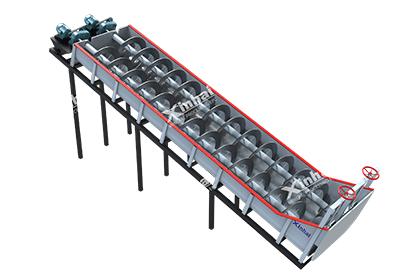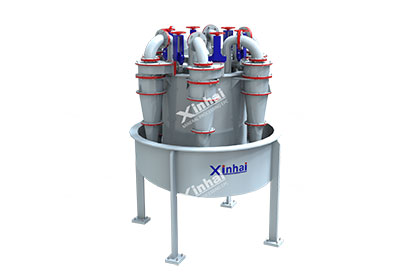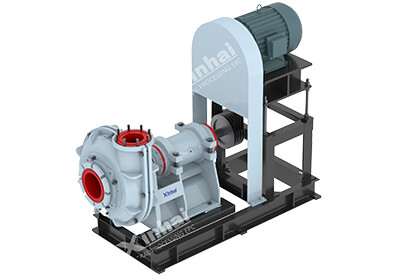What Is Spiral Classifier in Mineral Processing?
 Laura
Laura
 Jan 27, 2022
Jan 27, 2022
 5651
5651
If you want to know more details about equipment, solutions, etc, please click the button below for free consultation, or leave your requirements!

(Xinhai mineral spiral classifier in ore processing plant)
Spiral classifier is a common classification equipment used in mineral processing plants. It has the characteristics of simple structure, reliable operation, large processing capacity, stable classification area and high classification efficiency.
Below we briefly introduce its importance, working principle, application and main classification.
01 Why is Spiral Classifier so Important?
BackIn the mineral separation process, the ore needs to be ground to a certain fineness so that the useful minerals embedded in fine grains and gangue can be fully dissociated and sorted, and at the same time, excessive grinding should be avoided to prevent sludge from affecting the sorting process. In this case, it is necessary to return the unqualified part of the grinding ore to the mill for cyclic grinding through the classification equipment, and the qualified part of the particle size should be separated out and sent to the sorting operation in time to avoid unnecessary grinding. In terms of technical and economic significance, grading plays an extremely important role in grinding operations.

(Spiral classifier in gold processing plant)
At present, the most commonly used classification equipment in concentrators mainly includes classifiers and hydrocyclones. Among them, classifiers include spiral classifiers, rake classifiers, floating trough classifiers and other types. With the continuous improvement of classification requirements, rake classifiers are gradually replaced by spiral classifiers due to their complex structure and poor classification effect; floating trough classifiers are gradually replaced by hydrocyclones due to their large footprint and low classification efficiency.
As a result, spiral classifiers and hydrocyclones are the main options for classification operations in concentrators today. Although the rapid development of the cyclone once made the spiral classifier lose its importance, with the continuous changes in the needs of the dressing plant, it was found that the spiral classifier also has its advantages:
1) The returning sand is automatically raised to a certain height and then directly returned to the feeding end of the ball mill, eliminating the need for feeding equipment and saving construction investment;
2) The continuity and stability of the returned sand, and the high concentration of the returned sand is beneficial to improve the grinding concentration, thereby improving the grinding efficiency;
3) The grading particle size can be controlled according to the feeding amount and overflow concentration;
4) Simple structure, convenient operation and management, reliable operation and low maintenance cost.

(Spiral classifier in copper processing plant)
02 How does Spiral Classifier Work?
Back1). Working Principle
The spiral classifier is based on the principle that the size of the solid particles and the specific gravity are different, so the sedimentation speed in the liquid is different. It is a kind of grading equipment that is pushed up by the screw and discharged to the top for mechanical grading. It can grade the powder in the mill for filtration, and then use the spiral blade to rotate the coarse material into the feed port of the mill to filter the filtration. The outgoing fines are discharged from the overflow pipe.

(Structure drawing of high dam sprial classifier)
2). Main Application
a) Formed with ball mill to form a closed-circuit cycle and split-range ore sand;
b) Used to classify ore sand and fine mud;
c) Grain size classification of ore pulp in metal beneficiation process;
d) Desliming, dehydration and other operations in ore washing operations.
03 Main Classification
BackCommon spiral classifiers can be classified according to the overflow height, that is, the position of the spiral in the water tank is different from the height of the pulp surface. The spiral classifier can be divided into three types: high dam type, low dam type and submerged type.
1). High Dam Spiral Classifier
The high dam type spiral classifier means that the overflow dam is higher than the spiral axis of the spiral, but lower than the upper edge of the spiral at the overflow end. There are high dam type single spiral and double spiral classification. This kind of classifier has a lower settlement area and a larger dam type, and its dam height can be adjusted within a certain range, that is, the area of the settlement area can be adjusted and changed within a certain range, so that the particle size of classification can be adjusted, which is an important part in the grinding cycle. A commonly used device. And it is mainly used for ore classification with overflow particle size of 0.83mm to 0.15mm.

2). Low Dam Spiral Classifier
The low dam type is that the overflow dam is lower than the screw axis of the screw. Due to the small area of the settling area, it can only be used for washing sand ores with little mud and dewatering of coarse particles in actual production, but it is rarely used in grinding cycles.
3). Submerged Spiral Classifier
The submerged type is that there are 4-5 spiral blades at the end of the overflow dam, all of which are submerged in the pulp. There are also two types of single spiral and double spiral. The classifier has a large settlement area, a deep classification pool, and the agitation of the spiral has little effect on the surface of the pulp, so the classification surface is stable, and the overflow is large and fine. And it is used for ore classification with overflow particle size of 0.15mm to 0.07mm.

(Spiral classifier in iron processing plant)
04To Sum Up
BackThe above classification equipment types have their own advantages, and also have different degrees of influence on the equipment classification efficiency. According to the current different grading requirements, different types of grading equipment have been optimized and improved accordingly, in order to achieve good grading results. When choosing spiral classifier, each dressing plant must clearly grasp its type characteristics and working principle, and consider the ideal process and equipment in combination with its own processing plant production needs.
If any questions, feel free to leave a message or contact us to learn more about spiral classifier models and application cases!
 +86 18716000713
+86 18716000713 xlyin@xinhaimining.net
xlyin@xinhaimining.net




 Message
Message Chat Now
Chat Now

















